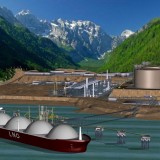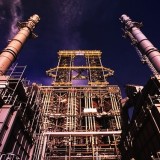The proposed Enbridge and Kinder Morgan bitumen pipelines through BC are finally receiving the attention they deserve – as is the much-needed corollary conversation on the Alberta Tar Sands and their true impact on Canada’s economic future, elevated to national prominence by Official Opposition leader Thomas Mulcair. Yet, as big of a game-changer as oil pipelines and tankers would be for BC, one could argue that the collection of proposed natural gas-related developments on the table is, taken together, at least as transformative for the province’s future – though you wouldn’t know it from the relative silence on the topic.
Until recently, that is. The past several months have seen a number of highly significant events related to this matter.
First, in mid-June, Apache Canada announced a massive new shale gas find in the Liard Basin, which stretches from northeast BC into the southeast corner of the Yukon. The Liard play, being touted as the “best shale gas reservoir in North America”, is west of the Horn River basin play, already one of the world’s largest. The find is undoubtedly a game-changer, elevating northeast BC to the world’s mecca for the relatively new, yet highly controversial process for breaking open shale gas formations deep underground, known as “fracking”.
The next big development came the day after Apache’s announcement, when the NDP, led by Energy Critic and likely future Energy Minister John Horgan, came out fully supporting an expanded natural gas industry in Northeast BC, downplaying environmental concerns about fracking. In the same breath, the Official Opposition showed clear support for the Liberal plan to build a number of Liquid Natural Gas (LNG) plants in Kitimat to export the resource to Asia.
The party’s position was solidified last week when the Georgia Straight reported it was fully backing a new pipeline from Summit Lake, north of Prince George – Encana, EOG and Apache Canada’s joint venture Pacific Trails Pipeline – to carry natural gas from northeast BC to three proposed LNG refineries in Kitimat.
Finally, Premier Christy Clark announced a week later that her government will be reclassifying previously dirty natural gas as “clean” – but only when it’s burned to power these proposed LNG plants in Kitimat. The Campbell/Clark Government previously banned the development of new gas-fired electrical plants, putting the emphasis on renewable or so-called “clean” energy alternatives – wind, solar, geothermal, biomass and hydro.
The premise for these new multi-billion dollar LNG plants is to access new markets in Asia which currently pay far more for gas than North American customers. Prices in China, Japan and Korea range up to $17 per thousand cubic feet versus a historic low of two to three dollars in North America today – largely thanks to the glut of natural gas flooding the domestic market as a result of new shale gas plays. The idea is to turn some of BC’s plentiful gas supply into liquid, put it on tankers and ship it to Asia to reap big profits. Without these prices, big finds like Apache’s in the Liard Basin simply don’t make sense to develop.
While the plan looks financially (though certainly not environmentally) promising on the surface, it’s fraught with complications:
1. The process of converting gas to liquid is enormously energy intensive. According to Christy Clark, all the the power from BC Hydro’s proposed new 1,100 Megawatt Site C Dam on the Peace River would be required for just Shell’s one proposed LNG plant in Kitimat. That may have changed, now that these plants are allowed to burn their own cheap gas for power, but, curiously, Site C Dam has not been taken off the table in the wake of that announcement. The otherwise energy self-sufficient BC has nowhere near enough electrical supply to power three new LNG plants and all the new mines the Clark Government is pushing forward.
2. The whole plan is contingent on this high price differential carrying forward – which is doubtful for a number of reasons. China’s economy is already showing signs of slowing down, while Japan is looking to restart its nuclear program; where will its energy demand be in 10 years when these plants are built and supplying the Asian market with LNG?
3. We’re not the only horse in the race. China has its own shale gas plays – which it is now starting to develop. Moreover, a number of other countries are thinking the same way we are – chief among them Australia, which is much further along and has already secured contracts to sell LNG to China.
4. The main method of supplying these plants – gas from fracking operations – is coming under increased scrutiny globally, with various moratoria having been instituted in other regions, relating to concerns over water use and contamination, earthquakes, and myriad human and animal health concerns. Fracking producers may well (and should) face increased regulation – meaning added costs and further reduced profits – or, worse, outright restrictions and shutting down of operations as awareness and evidence build against this controversial technique.
LNG and Mines Mean Site C
As befuddled and full of flip-flopery as the Liberals have been on this file, the NDP are in quite a pickle too. First, they give their environmental seal of approval to shale gas, while supporting the massively risky undertaking that is building and fueling multi-billion dollar plants on BC’s coast to turn this gas into liquid and ship it to new markets in Asia. But when the Liberals reclassify gas as “clean” (remember, the NDP just did as much themselves not a week previous) in order to allow these plants to use their own gas to power the enormously energy-intensive liquid compression process, the Opposition cries foul. Why? Because burning gas isn’t clean. So which is it, Mr. Dix?
I filmed a rally in Victoria two years ago led by First Nations and farmers from the Peace Valley in opposition to Site C Dam. NDP Energy Critic John Horgan, to his credit, attended the rally and spoke – but he stopped short of outright opposing the dam. He would only say that it required a full environmental assessment and that it should only proceed if the science supports it.
Then, in January, 2011, Horgan told the Georgia Straight that he didn’t think Site C was “necessary” at the time – though still leaving the door open to the project:
They want some peace in the valley, and as long as the spectre of Site C hangs over their head, there’s never going to be a comfort level in the community,” Horgan said. “They want a full-fledged, full-on environmental assessment, so that they can put on the table the science of the sloughing, the costs of dredging, and the total costs on ratepayers of a $6- to $7- to $8- or even $9-billion project.
Earlier this year, my colleague at the Common Sense Canadian, Rafe Mair put NDP leader Adrian Dix on the spot regarding Site C and got more of the same fence-sitting.
To my understanding, the NDP is on the fence or publicly committed to the above schemes – Site C, fracking, LNG – for three main reasons:
1. It is conscious of not allowing itself to be branded by its political opponents as “anti-progress” or “anti-industry”, especially after having taken a strong position against the Enbridge pipeline
2. It is wary of not stepping on the toes of First Nations who have signed onto to the LNG scheme – particularly the Haisla Nation of Kitimat, who have also been vocal opponents of the Enbridge pipeline.
3. It recognizes how much the province’s coffers have come to depend on royalties, licenses and other fees related to the natural gas industry and doesn’t want to disturb that flow, leading to big deficits that will play into its opponents’ hands.
While these are all politically understandable reasons for supporting this massive industrialization of northern BC, they do not excuse the arguments against this program.
In the very least, the environmental and health concerns associated with fracking and the loss of vital farmland and fish and wildlife habitat from Site C – not to mention the notion of massive public subsidies for an industry on less than solid ground going forward – should argue for a more mature position from the province’s government-in-waiting. They know this whole scheme is fraught with complications and this outright endorsement of it shows the NDP is ready to put short-term politics ahead of reasoned, long-term policy for the province.
Subsidizing Energy for Industry
Clearly, Site C, mining, fracking, LNG are all interrelated. Even if Site C isn’t used to power LNG, there are over a dozen proposed new mines in northern BC – each of which is hungry for taxpayer-subsidized electricity. This begs the question – one answered by economist Erik Andersen in a recent interview with Rafe Mair: should the public be subsidizing new industry at all, with skyrocketing power bills and new $10-plus billion dam projects like Site C?
One of the key bones of contention at this year’s failed Rio climate conference was the matter of ending subsidies for hydrocarbon production. Plainly, this is a no-brainer, if we are to get on with the necessary transition away from fossil fuels to more sustainable energy sources. Moreover, the wealthiest corporations in history are the last entities that should be receiving public subsidies. And yet, we learned through a leaked memo that the Harper Government was leading the charge against the move to end hydrocarbon subsidies. So much for the “free market” Stephen Harper and his fellow Milton Friedman disciples keep railing on about!
So in that regard, it makes abundant sense for the natural gas industry to use some of its own product to supply the enormous energy needs of these LNG plants. And yet, anyone should be able to recognize the environmental folly of reclassifying gas as “clean” to enable its burning, to ship more gas half way around the world to be…burned. And that’s ignoring the myriad environmental problems associated with the initial extraction of the gas through fracking.
A Looming Boondoggle
No matter the degree to which Site C or our public hydroelectric system are used to power this LNG program, the taxpayers of BC, as shareholders in our gas resource, are impacted by the choices the industry makes on numerous levels. We need to ask whether this LNG-Asian market vision is an economically viable, environmentally responsible idea, or an epic resource boondoggle in the making, as we have seen in the past with similar forays into the Asia market with our coal and timber.
These political parties and the industry are banking on achieving a higher price for their gas in Asian markets – particularly China and Japan. But China has its own shale gas potential and is only just beginning to develop it. On top of that, China’s economy – and thus energy demand – is showing real signs of faltering. It will take us 5-10 years to build all these LNG plants and the additional energy assets to power them. Will China still be paying premium prices for LNG a decade from now, given the volatility of the various factors which enable that pricing today?
There are other players, such as Korea and Southeast Asia who might. Petronas Energy of Malaysia recently scooped up Candian gas company Progress Energy for over $5 Billion.
But this raises another question: how will this benefit the BC and Canadian economy – especially in light of new labour laws from the Harper Government that allow companies like Petronas to import foreign workers and pay them 15% less than Canadian employees. So under this system, we could see many jobs going to foreigners (excepting those that are too technical to be done by cheap, imported workers), while these new profits flow out of Canada, along with the energy resource.
This LNG scheme – as with plans to export Alberta bitumen to Asia – should be viewed as a hail mary pass to try and get the Canadian oil and gas industry out of the financial pit into which it is presently sinking. With prices where they are, there is a real danger that BC’s once-thriving industry could collapse, without a North American market willing to pay a reasonable price for its product. And yet, Site C, LNG and fracking, taken together – as they should be – constitute a massive gamble for the citizens of Birtish Columbia, both environmentally and economically. As such it’s time we have a frank conversation about the issue before rushing headlong into a potential boondoggle of unprecedented proportions for our province.
Perhaps what needs to happen here – from both an environmental and economic perspective – is a planned ramping down of the North American natural gas supply, until prices begin to stabilize again. As energy economists like Jeff Rubin argue, the most effective way to regulate energy consumption is through price. Clearly, at $2-3/unit of energy, there is no incentive for the North American public or industry to conserve natural gas. Nor does this price point benefit the gas industry or the public, who are partners in the resource through the royalties and tax dollars we receive from its sale – all of which are significantly diminished in this climate. And yet, reducing supply in the North American market would be a tremendous undertaking that requires a level of collusion – and may not be practical, regardless, with hundreds of companies looking out for their own short-term interests.
In any event, while the public reaction and much-needed discussion around these issues have been delayed, there are signs they are now developing quickly. The political discussion surrounding the issue is intensifying, as is the media’s coverage of it. Already, the bubble shows signs of bursting, as Kitimat LNG – the joint venture between Encana, EOG and Apache – was recently delayed by another year as the consortium has yet to sign the contracts it needs with Asian buyers to finance the project. Meanwhile, some First Nations and environmentalists are beginning to organize protests against the consortium’s Pacific Trails Pipeline – the primary connector between fracked gas of northeast BC and this and other proposed LNG plants on the coast. Opposition to Site C Dam has been steadily growing as well, as I documented at this year’s record-setting ‘Paddle for the Peace’.
It’s high time this issue generated some of the intensity that the Enbridge project has received – as it would likely have as big, if not an even greater cumulative impact on the future of this province, environmentally and socioeconomically.





